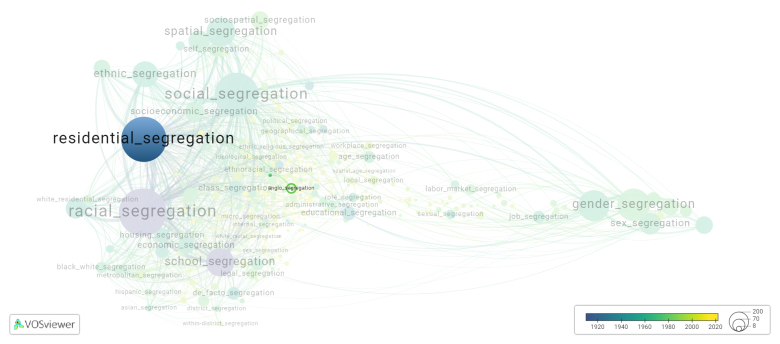Anglo segregation: Difference between revisions
(Creating page) |
(Creating page) |
||
| Line 22: | Line 22: | ||
[[File:anglo_segregation.png|780x780px]] | [[File:anglo_segregation.png|780x780px]] | ||
Visualization based on the [[How_to_cite_Segregation_Wiki| research]] | |||
For the complete network of associated segregation forms, see: | For the complete network of associated segregation forms, see: | ||
year of publication https://tinyurl.com/2235lkhw | * First year of publication https://tinyurl.com/2235lkhw | ||
Louvain clusters https://tinyurl.com/2d8wg5n3 | * Louvain clusters https://tinyurl.com/2d8wg5n3 | ||
* Betweenness centrality https://tinyurl.com/223udk5r | |||
* Disciplines where segregation forms first appeared https://tinyurl.com/244d8unz | |||
==References== | ==References== | ||
==Notes== | ==Notes== | ||
Revision as of 13:40, 3 October 2024
Date and country of first publication[1]
1992
United States
Definition
Anglo segregation refers to the practice of segregating individuals of Anglo descent from other racial and ethnic groups. This type of segregation primarily occurred in the United States, especially during the era of Jim Crow laws and racial segregation in the early to mid-20th century.
During this time, Anglo Americans, who were primarily of white European descent, enjoyed social, economic, and political privileges that were denied to non-white racial or ethnic groups. This segregation was enforced through various means, including laws, regulations, and social customs that promoted the separation of different races.
Anglo segregation was most evident in the South, where racial segregation was legally mandated in schools, public facilities, transportation, and housing. African Americans and other racial or ethnic minorities were subjected to separate and unequal facilities, services, and opportunities.
Anglo segregation also extended to other parts of the country, albeit to a lesser degree. Residential segregation was common in many areas, where neighborhoods were racially homogenous and racially restrictive covenants prevented non-Anglos from buying or renting homes in Anglo-dominated areas.
The Civil Rights Movement of the 1950s and 1960s challenged and ultimately dismantled many of these segregationist practices. Civil rights activists fought for the integration of schools, public facilities, and housing, seeking to end the systemic barriers that perpetuated racial inequality.
While legal segregation has been abolished, its legacy persists in the form of socioeconomic disparities, racial discrimination, and residential segregation. Efforts to address and eliminate systemic racism continue to be ongoing in many societies.
See also
Related segregation forms
Anglo segregation is frequently discussed in the literature with the following segregation forms:
residential segregation, puerto rican segregation

Visualization based on the research
For the complete network of associated segregation forms, see:
- First year of publication https://tinyurl.com/2235lkhw
- Louvain clusters https://tinyurl.com/2d8wg5n3
- Betweenness centrality https://tinyurl.com/223udk5r
- Disciplines where segregation forms first appeared https://tinyurl.com/244d8unz
References
Notes
- ↑ Date and country of first publication as informed by the Scopus database (December 2023).
At its current state, this definition has been generated by a Large Language Model (LLM) so far without review by an independent researcher or a member of the curating team of segregation experts that keep the Segregation Wiki online. While we strive for accuracy, we cannot guarantee its reliability, completeness and timeliness. Please use this content with caution and verify information as needed. Also, feel free to improve on the definition as you see fit, including the use of references and other informational resources. We value your input in enhancing the quality and accuracy of the definitions of segregation forms collectively offered in the Segregation Wiki ©.
Anglo segregation appears in the following literature
Massey D.S., Denton N.A. (1987). Trends in the residential segregation of blacks, Hispanics, and Asians: 1970 1980. American Sociological Review, 52(6), 802-825. https://doi.org/10.2307/2095836
Santiago A.M. (1992). Patterns of Puerto Rican Segregation and Mobility. Hispanic Journal of Behavioral Sciences, 14(1), 107-133. https://doi.org/10.1177/07399863920141006
